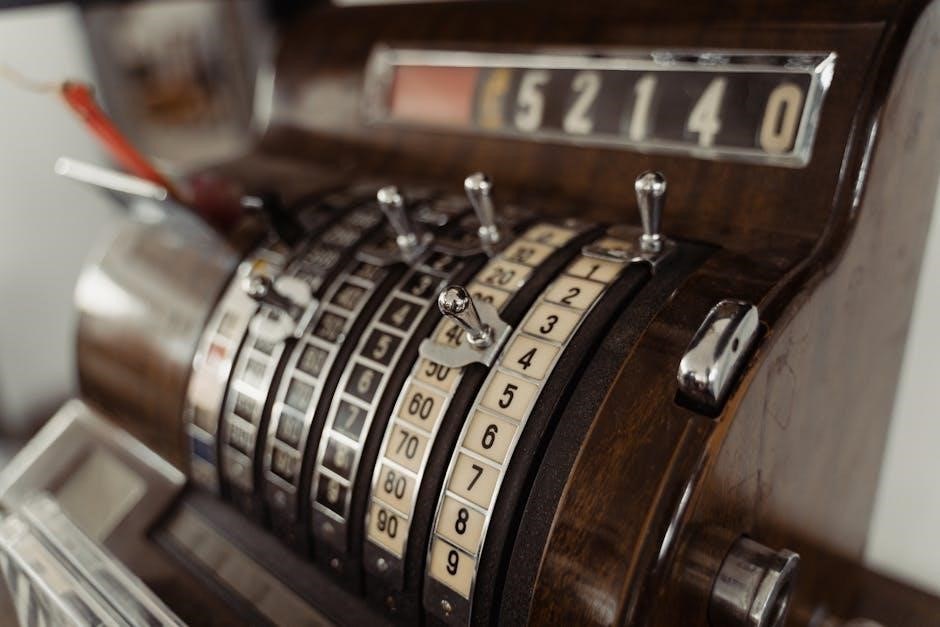A decimal place value chart is a visual tool that helps students understand the relationship between digits in whole numbers and decimals․ It breaks down numbers into hundreds, tens, ones, tenths, hundredths, and thousandths, making complex concepts easier to grasp․ This chart is essential for teaching place value, as it provides a clear structure for understanding how each digit’s value changes based on its position․ By using a printable PDF, educators can create customized resources that cater to different learning needs, ensuring students master decimal place value effectively․ These charts are invaluable for building a strong foundation in mathematics, especially when introducing decimals to young learners․
Definition of a Decimal Place Value Chart
A decimal place value chart is a visual tool that organizes numbers to illustrate their place values, both for whole numbers and decimals․ It breaks down numbers into columns representing hundreds, tens, ones, tenths, hundredths, and thousandths․ This chart helps students understand how each digit’s value changes based on its position relative to the decimal point․ By visually separating the places, it simplifies complex mathematical concepts, making them easier to comprehend and apply․
Importance of Understanding Decimal Place Value
Understanding decimal place value is crucial for grasping mathematical concepts like addition, subtraction, and real-world applications such as money, measurements, and fractions․ It helps students recognize how digits represent different values based on their position, enhancing mental math skills and problem-solving abilities․ Mastery of decimal place value builds a strong foundation for advanced math, ensuring accuracy in calculations and a deeper understanding of numerical relationships․
Structure of a Decimal Place Value Chart
A decimal place value chart organizes numbers into whole number places (hundreds, tens, ones) and decimal places (tenths, hundredths, thousandths), separated by a decimal point․
Whole Number Places (Hundreds, Tens, Ones)
The whole number places in a decimal place value chart represent hundreds, tens, and ones․ Each position to the left increases the place value by a factor of 10․ The hundreds place shows groups of 100, the tens place groups of 10, and the ones represent individual units․ This hierarchy helps students break down whole numbers into manageable parts, enhancing their understanding of numerical structure and relationships between digits․
Decimal Places (Tenths, Hundredths, Thousandths)
Decimal places, including tenths, hundredths, and thousandths, represent fractions of a whole․ The tenths place is the first digit after the decimal point, representing 1/10․ The hundredths place is the second, denoting 1/100, and the thousandths place is the third, symbolizing 1/1000․ These places help students understand how each digit’s value decreases exponentially as they move right, essential for grasping decimal concepts in mathematics and real-world applications․
Visual Representation of the Decimal Point
The decimal point is visually represented as a dot separating whole numbers from decimals in a place value chart․ It clearly distinguishes the ones place from the tenths place, helping students understand the transition from whole to fractional values․ This visual separation is crucial for grasping how digits to the left of the decimal represent whole quantities, while those to the right represent fractions, enhancing clarity in place value concepts․
Creating a Printable Decimal Place Value Chart in PDF
Design a custom decimal place value chart in PDF format for clear, organized learning․ Include whole number and decimal places, such as tenths, hundredths, and thousandths, ensuring easy customization and classroom use․
Steps to Design a Custom Decimal Place Value Chart
To create a custom decimal place value chart, start by defining the structure, including whole number places (hundreds, tens, ones) and decimal places (tenths, hundredths, thousandths)․ Use a template or design tool to organize the layout․ Add labels and markings to distinguish between whole numbers and decimals․ Incorporate visual separators, such as lines or boxes, to enhance clarity․ Customize the chart with colors or fonts for better readability․ Finally, review and ensure accuracy before saving and printing as a PDF․
Benefits of Using a PDF Format for Place Value Charts
Using PDF format for place value charts offers numerous advantages․ PDFs maintain consistent formatting across devices, ensuring clarity and readability․ They are easily downloadable and printable, making them accessible for classroom or home use․ PDFs can be customized with interactive features, such as fillable fields, enhancing student engagement․ Additionally, PDFs are sharable and can be integrated into digital lesson plans, providing a versatile resource for educators․ This format also supports long-term storage and reuse, making it a practical choice for educational materials․

Interactive Decimal Place Value Charts
Interactive decimal place value charts provide engaging learning experiences by allowing students to manipulate digits and visualize place value relationships dynamically․ These tools enhance understanding through hands-on exploration and real-time feedback, making complex concepts more accessible and fun for learners of all ages․
Online Tools for Generating Interactive Charts
Several online tools allow educators to create interactive decimal place value charts, enhancing student engagement․ Platforms like GeoGebra and Math Playground offer customizable templates where students can explore place value digitally․ These tools provide real-time feedback and visualization, making abstract concepts tangible․ Teachers can tailor charts to specific lessons, ensuring a personalized learning experience․ Such resources are accessible via web browsers, supporting both classroom and remote learning environments effectively․
How to Use Digital Charts for Engaging Learning
Digital charts offer an interactive way to teach decimal place value, making learning dynamic and engaging․ Teachers can use tools like GeoGebra to create movable pieces or sliders, allowing students to visualize how digits change value when moved․ Real-time feedback and animations help reinforce concepts․ Additionally, digital charts can be shared via links, enabling students to practice independently․ This approach caters to diverse learning styles and promotes active participation in lessons․

Place Value Worksheets with Decimals
Decimal place value worksheets provide structured practice for understanding tenths, hundredths, and thousandths․ These PDF resources offer exercises that build confidence in identifying and writing decimal values accurately, reinforcing place value concepts through hands-on activities and clear examples․ They are ideal for classroom or independent learning, catering to different skill levels and learning styles․
Types of Worksheets for Practicing Decimal Place Value
Worksheets for decimal place value include fillable charts, writing expanded forms, and matching activities․ They help students identify tenths, hundredths, and thousandths, aligning with PDF charts for comprehensive learning․ Exercises range from basic recognition to complex conversions, ensuring a gradual skill progression․ Interactive and printable formats make these resources versatile for various teaching methods, enhancing engagement and understanding of decimal place value concepts effectively․
Resources for Downloading Printable Worksheets
Numerous websites offer free printable worksheets for decimal place value practice․ The Curriculum Corner provides customizable templates and interactive charts, while other platforms offer PDF versions for easy downloading․ These resources include fillable charts, expanded form exercises, and matching activities; Teachers can access a variety of worksheets tailored to different skill levels, ensuring comprehensive learning․ These tools are ideal for classroom use or independent study, making decimal place value mastery accessible and engaging for all students․
Examples of Decimal Place Value Charts
Decimal place value charts provide clear visual representations, breaking numbers into whole number places (hundreds, tens, ones) and decimal places (tenths, hundredths, thousandths)․ For example, the number 4,352․567 is divided into 4 (thousands), 3 (hundreds), 5 (tens), 2 (ones), 5 (tenths), 6 (hundredths), and 7 (thousandths)․ Such charts are available as printable PDFs, offering practical tools for teaching and learning decimal concepts effectively․
Sample Charts for Whole Numbers and Decimals
Sample charts for whole numbers and decimals visually organize numbers into place values, such as hundreds, tens, ones, tenths, hundredths, and thousandths․ For instance, the number 4,352․567 is broken down into 4 (thousands), 3 (hundreds), 5 (tens), 2 (ones), 5 (tenths), 6 (hundredths), and 7 (thousandths)․ These charts are available as printable PDFs, making them easy to use for classroom activities or homework․ They provide a clear, structured way to understand how each digit’s position affects its value, helping students master both whole numbers and decimals․ Real-world applications, such as money and measurements, further highlight their importance in everyday math skills․
Real-World Applications of Decimal Place Value
Decimal place value is essential in everyday activities like handling money, where cents represent tenths and hundredths․ In cooking, precise measurements require understanding tenths and hundredths for accurate recipes․ Science and engineering rely on decimal place value for precise calculations․ Sports timing, such as 100-meter dashes, uses decimals for accuracy․ These real-world applications highlight the importance of mastering decimal place value for practical problem-solving and everyday tasks, making it a foundational math skill․

Top Resources for Teachers and Educators
Recommended websites like www․thecurriculumcorner․com and mathworksheets4kids․com offer free printable PDF charts for teaching decimal place value, providing easy-to-use resources for classroom or personal learning environments․
Recommended Websites for Decimal Place Value Charts
Websites like www․thecurriculumcorner․com and mathworksheets4kids․com provide excellent printable PDF charts for teaching decimal place value․ These resources offer customizable templates, covering whole numbers and decimals up to thousandths․ They are ideal for educators seeking structured tools to help students visualize place value relationships․ Additionally, teacherspayteachers․com offers a variety of decimal place value charts and worksheets, making it a go-to destination for classroom materials․ These websites cater to different learning needs and grade levels, ensuring teachers can find the perfect resource for their students․
How to Integrate Charts into Lesson Plans
Integrating decimal place value charts into lesson plans enhances student understanding; Begin by using the chart as a visual aid during instruction, highlighting how each digit’s position affects its value․ Incorporate interactive activities, such as labeling exercises or group work, to engage students․ Additionally, include the chart in assessments to reinforce learning․ Teachers can also use these charts to differentiate instruction, providing scaffolding for struggling learners․ Regular practice with the chart ensures mastery of decimal place value concepts․

Visual Design Tips for Effective Learning
Use clear, bold fonts and contrasting colors to differentiate whole number and decimal sections․ Ensure the layout is uncluttered, with ample spacing to avoid visual overload․ Highlight the decimal point distinctly to emphasize its importance․ Incorporate color-coding for each place value (e;g․, green for tenths, blue for hundredths) to enhance understanding and engagement․
Best Practices for Creating Clear and Concise Charts
Ensure charts are simple and uncluttered, focusing on key place values․ Use consistent formatting and clear labels for whole numbers and decimals․ Incorporate color-coding to differentiate sections, such as green for tenths and blue for hundredths․ Avoid overcrowding by separating whole number places (hundreds, tens, ones) from decimal places (tenths, hundredths, thousandths)․ Use bold fonts for headings and ensure the decimal point is prominently displayed․ Add visual cues like arrows or lines to show relationships between digits․ Provide examples for clarity, such as breaking down the number 4․352 into its place values․ Make sure charts are scalable for different grade levels and learning needs․ Include a legend or key for easy reference․ Ensure the chart is aligned with curriculum standards and includes interactive elements for engagement․ Regularly update charts to reflect student progress and understanding․ Use high-quality images or vectors for digital versions to maintain clarity․ Ensure charts are accessible for students with disabilities by using large text and high-contrast colors․ Offer customizable templates for teachers to tailor charts to specific lessons․ Include a section for students to practice labeling place values․ Provide a printable version for hands-on learning and a digital version for interactive use․ Include a guide for parents or tutors to support at-home learning․ Use real-world examples to illustrate the practical application of decimal place value․ Make charts available in multiple languages to accommodate diverse classrooms․ Ensure charts are compatible with various devices for online learning․ Include a section for common misconceptions and how to address them․ Provide a step-by-step guide for introducing the chart to students․ Include a section for advanced learners to explore beyond thousandths․ Use engaging visuals like icons or illustrations to make the chart more appealing․ Ensure charts are easy to navigate with clear section dividers․ Include a section for reviewing previous concepts to build a strong foundation․ Use charts in conjunction with worksheets for comprehensive practice․ Include a section for tracing and writing numbers to improve fine motor skills․ Use charts to teach the concept of money, where tenths represent dimes and hundredths represent pennies․ Include a section for comparing and contrasting whole numbers and decimals․ Use charts to introduce the concept of rounding decimals to the nearest tenth or hundredth․ Include a section for word problems to apply place value understanding․ Use charts to teach the relationship between fractions and decimals․ Include a section for converting decimals to fractions and vice versa․ Use charts to introduce the concept of decimal operations like addition and subtraction․ Include a section for estimating decimal sums or differences․ Use charts to teach the concept of decimal patterns and sequences․ Include a section for identifying place value in real-world measurements, such as weights or lengths․ Use charts to introduce the concept of scientific notation for large or small numbers․ Include a section for teaching the history of decimal systems and their importance in mathematics․ Use charts to introduce the concept of currency exchange rates․ Include a section for teaching the concept of percentages and their relationship to decimals․ Use charts to introduce the concept of ratios and proportions․ Include a section for teaching the concept of algebraic expressions using decimal place value․ Use charts to introduce the concept of data analysis and interpreting decimal data․ Include a section for teaching the concept of graphing decimals on a number line․ Use charts to introduce the concept of geometry measurements involving decimals․ Include a section for teaching the concept of time measurements in decimals, such as 0․5 hours․ Use charts to introduce the concept of money management and budgeting with decimals․ Include a section for teaching the concept of cooking and recipes using decimal measurements․ Use charts to introduce the concept of science experiments requiring precise decimal measurements․ Include a section for teaching the concept of engineering and blueprints using decimal place value․ Use charts to introduce the concept of architecture and scale models requiring decimal accuracy․ Include a section for teaching the concept of music and rhythm using decimal timings․ Use charts to introduce the concept of sports and scoring systems involving decimals․ Include a section for teaching the concept of health and medicine, where decimal accuracy is crucial․ Use charts to introduce the concept of environmental science and decimal data analysis․ Include a section for teaching the concept of technology and coding using decimal place value․ Use charts to introduce the concept of robotics and programming with decimal precision․ Include a section for teaching the concept of astronomy and decimal measurements in space exploration․ Use charts to introduce the concept of physics and decimal calculations in motion and forces․ Include a section for teaching the concept of chemistry and decimal measurements in lab experiments․ Use charts to introduce the concept of biology and decimal data in scientific research․ Include a section for teaching the concept of geology and decimal measurements in earth sciences․ Use charts to introduce the concept of economics and decimal data in financial analysis․ Include a section for teaching the concept of business and decimal calculations in accounting․ Use charts to introduce the concept of marketing and decimal data in consumer trends․ Include a section for teaching the concept of psychology and decimal data in behavioral studies․ Use charts to introduce the concept of sociology and decimal data in demographic analysis․ Include a section for teaching the concept of anthropology and decimal data in cultural studies․ Use charts to introduce the concept of history and decimal data in historical research․ Include a section for teaching the concept of philosophy and decimal logic in critical thinking․ Use charts to introduce the concept of art and decimal precision in design and creativity․ Include a section for teaching the concept of language arts and decimal logic in grammar and syntax․ Use charts to introduce the concept of music theory and decimal rhythm in compositions․ Include a section for teaching the concept of theater and decimal timing in performances․ Use charts to introduce the concept of dance and decimal precision in choreography․ Include a section for teaching the concept of visual arts and decimal measurements in sculptures and paintings․ Use charts to introduce the concept of culinary arts and decimal measurements in recipes․ Include a section for teaching the concept of fashion design and decimal precision in patterns and measurements․ Use charts to introduce the concept of interior design and decimal measurements in blueprints and layouts․ Include a section for teaching the concept of landscape design and decimal measurements in gardening and architecture․ Use charts to introduce the concept of urban planning and decimal measurements in city designs․ Include a section for teaching the concept of transportation engineering and decimal precision in road and bridge designs․ Use charts to introduce the concept of aerospace engineering and decimal calculations in rocket and aircraft designs․ Include a section for teaching the concept of mechanical engineering and decimal precision in machine designs․ Use charts to introduce the concept of electrical engineering and decimal calculations in circuit designs․ Include a section for teaching the concept of computer engineering and decimal precision in software and hardware designs․ Use charts to introduce the concept of biomedical engineering and decimal measurements in medical device designs․ Include a section for teaching the concept of environmental engineering and decimal data in pollution control and sustainability․ Use charts to introduce the concept of civil engineering and decimal measurements in construction and infrastructure․ Include a section for teaching the concept of chemical engineering and decimal calculations in plant and process designs․ Use charts to introduce the concept of nuclear engineering and decimal precision in reactor and fuel designs․ Include a section for teaching the concept of petroleum engineering and decimal measurements in oil and gas extraction․ Use charts to introduce the concept of agricultural engineering and decimal precision in farm and livestock management․ Include a section for teaching the concept of forestry engineering and decimal measurements in woodland and ecosystem management․ Use charts to introduce the concept of mining engineering and decimal precision in mineral extraction and processing․ Include a section for teaching the concept of materials engineering and decimal measurements in metal and polymer production․ Use charts to introduce the concept of industrial engineering and decimal calculations in manufacturing and supply chain management․ Include a section for teaching the concept of systems engineering and decimal precision in complex system designs․ Use charts to introduce the concept of telecommunications engineering and decimal measurements in network and signal designs․ Use charts to introduce the concept of information technology and decimal precision in data storage and retrieval systems․ Include a section for teaching the concept of cybersecurity and decimal logic in encryption and decryption algorithms․ Use charts to introduce the concept of artificial intelligence and decimal precision in machine learning models․ Include a section for teaching the concept of data science and decimal data analysis in predictive modeling․ Use charts to introduce the concept of business analytics and decimal calculations in market trend analysis․ Include a section for teaching the concept of financial technology and decimal precision in blockchain and cryptocurrency transactions․ Use charts to introduce the concept of digital marketing and decimal data in SEO and social media analytics․ Include a section for teaching the concept of e-commerce and decimal measurements in online shopping and payment systems․ Use charts to introduce the concept of web development and decimal precision in responsive design and user interfaces․ Include a section for teaching the concept of mobile app development and decimal measurements in user experience and performance metrics․ Use charts to introduce the concept of cloud computing and decimal precision in storage and scalability metrics․ Include a section for teaching the concept of internet of things and decimal data in sensor measurements and automation․ Use charts to introduce the concept of big data and decimal calculations in data processing and visualization․ Include a section for teaching the concept of DevOps and decimal precision in continuous integration and deployment pipelines․ Use charts to
Using Color and Layout to Enhance Understanding
Use color-coding to differentiate sections, such as green for tenths and blue for hundredths․ Ensure a clean layout with clear labels for whole numbers and decimals․ Separate whole number places (hundreds, tens, ones) from decimal places (tenths, hundredths, thousandths) for clarity․ Use bold fonts for headings and ensure the decimal point is prominently displayed․ This visual organization helps students grasp the relationship between digits and their positions, making learning more intuitive and engaging․
